An Experimental and Systematic Insight into the Temperature Sensitivity for a 0.15-µm Gate-Length HEMT Based on the GaN Technology
Abstract
1. Introduction
2. Device under Test and Experimental Details
3. Experimental Results and Systematic Analysis
3.1. Sensitivity-Based Analysis of DC Characteristics
3.2. Sensitivity-Based Analysis of Small-Signal Parameters and RF Figures of Merit
4. Conclusions
Author Contributions
Funding
Institutional Review Board Statement
Informed Consent Statement
Data Availability Statement
Conflicts of Interest
References
- Heller, E.R.; Crespo, A. Electro-thermal modeling of multifinger AlGaN/GaN HEMT device operation including thermal substrate effects. Microelectron. Reliab. 2008, 48, 45–50. [Google Scholar] [CrossRef]
- Bertoluzza, F.; Delmonte, N.; Menozzi, R. Three-dimensional finite-element thermal simulation of GaN-based HEMTs. Microelectron. Reliab. 2009, 49, 468–473. [Google Scholar] [CrossRef]
- Zhang, Y.; Sun, M.; Liu, Z.; Piedra, D.; Lee, H.-S.; Gao, F.; Fujishima, T.; Palacios, T. Electrothermal Simulation and Thermal Performance Study of GaN Vertical and Lateral Power Transistors. IEEE Trans. Electron Devices 2013, 60, 2224–2230. [Google Scholar] [CrossRef]
- Chvála, A.; Marek, J.; Príbytný, P.; Šatka, A.; Donoval, M.; Donoval, D. Effective 3-D device electrothermal simulation analysis of influence of metallization geometry on multifinger power HEMTs properties. IEEE Trans. Electron Device 2017, 64, 333–336. [Google Scholar] [CrossRef]
- Gupta, M.P.; Vallabhaneni, A.K.; Kumar, S. Self-consistent electrothermal modeling of passive and microchannel cooling in AlGaN/GaN HEMTs. IEEE Trans. Compon. Packag. Manuf. Technol. 2017, 7, 1305–1312. [Google Scholar] [CrossRef]
- Hao, Q.; Zhao, H.; Xiao, Y.; Kronenfeld, M.B. Electrothermal studies of GaN-based high electron mobility transistors with improved thermal designs. Microelectron. Reliab. 2018, 116, 496–506. [Google Scholar] [CrossRef]
- Akita, M.; Kishimoto, S.; Mizutani, T. High-frequency measurements of AlGaN/GaN HEMTs at high temperatures. IEEE Electron. Device Lett. 2001, 22, 376–377. [Google Scholar] [CrossRef]
- Nuttinck, S.; Gebara, E.; Laskar, J.; Harris, H.M. Study of self-heating effects, temperature-dependent modeling, and pulsed load-pull measurements on GaN HEMTs. IEEE Trans. Microw. Theory Tech. 2001, 49, 2413–2420. [Google Scholar] [CrossRef]
- Lee, J.W.; Webb, K.J. A temperature-dependent nonlinear analytic model for AlGaN-GaN HEMTs on SiC. IEEE Trans. Microw. Theory Tech. 2004, 52, 2–9. [Google Scholar] [CrossRef]
- Thorsell, M.; Andersson, K.; Fagerlind, M.; Südow, M.; Nilsson, P.-A.; Rorsman, N. Thermal study of the high-frequency noise in GaN HEMTs. IEEE Trans. Microw. Theory Tech. 2009, 57, 19–26. [Google Scholar] [CrossRef]
- Darwish, A.M.; Huebschman, B.D.; Viveiros, E.; Hung, H.A. Dependence of GaN HEMT millimeter-wave performance on temperature. IEEE Trans. Microw. Theory Tech. 2009, 57, 3205–3211. [Google Scholar] [CrossRef]
- Darwish, A.M.; Ibrahim, A.A.; Hung, H.A. Temperature Dependence of GaN HEMT Small Signal Parameters. Int. J. Microw. Sci. Technol. 2011, 2011, 945189. [Google Scholar] [CrossRef]
- Marinković, Z.; Crupi, G.; Caddemi, A.; Avolio, G.; Raffo, A.; Marković, V.; Vannini, G.; Schreurs, D.M.M.-P. Neural approach for temperature-dependent modeling of GaN HEMTs. Int. J. Numer. Model. Electron. Netw. Devices Fields 2014, 28, 359–370. [Google Scholar] [CrossRef]
- Crupi, G.; Raffo, A.; Avolio, G.; Schreurs, D.M.M.-P.; Vannini, G.; Caddemi, A. Temperature influence on GaN HEMT equivalent circuit. IEEE Microw. Wirel. Comp. Lett. 2016, 26, 813–815. [Google Scholar] [CrossRef]
- Alim, M.A.; Rezazadeh, A.A.; Gaquiere, C. Temperature effect on DC and equivalent circuit parameters of 0.15-μm gate length GaN/SiC HEMT for microwave applications. IEEE Trans. Microw. Theory Tech. 2016, 64, 3483–3491. [Google Scholar] [CrossRef]
- Zhao, X.; Xu, Y.; Jia, Y.; Wu, Y.; Xu, R.; Li, J.; Hu, Z.; Wu, H.; Dai, W.; Cai, S. Temperature-Dependent Access Resistances in Large-Signal Modeling of Millimeter-Wave AlGaN/GaN HEMTs. IEEE Trans. Microw. Theory Tech. 2017, 65, 2271–2278. [Google Scholar] [CrossRef]
- Bouslama, M.; Gillet, V.; Chang, C.; Nallatamby, J.-C.; Sommet, R.; Prigent, M.; Quere, R.; Lambert, B. Dynamic Performance and Characterization of Traps Using Different Measurements Techniques for the New AlGaN/GaN HEMT of 0.15-µm Ultrashort Gate Length. IEEE Trans. Microw. Theory Tech. 2019, 67, 2475–2482. [Google Scholar] [CrossRef]
- Alim, M.A.; Hasan, M.A.; Rezazadeh, A.A.; Gaquiere, C.; Crupi, G. Multibias and temperature dependence of the current-gain peak in GaN HEMT. Int. J. RF Microw. Comput. Aided Eng. 2019, 30, e22129. [Google Scholar] [CrossRef]
- Crupi, G.; Raffo, A.; Vadalà, V.; Vannini, G.; Caddemi, A. High-periphery GaN HEMT modeling up to 65 GHz and 200 °C. Solid-State Electron. 2019, 152, 11–16. [Google Scholar] [CrossRef]
- Chen, Y.; Xu, Y.; Kong, Y.; Chen, T.; Zhang, Y.; Yan, B.; Xu, R. Temperature-dependent small signal performance of GaN-on-diamond HEMTs. Int. J. Numer. Model. Electron. Netw. Dev. Field 2020, 33, e2620. [Google Scholar] [CrossRef]
- Gryglewski, D.; Wojtasiak, W.; Kamińska, E.; Piotrowska, A. Characterization of self-heating process in GaN-based HEMTs. Electronics 2020, 9, 1305. [Google Scholar] [CrossRef]
- Majumdar, A.; Chatterjee, S.; Chatterjee, S.; Chaudhari, S.S.; Poddar, D.R. An ambient temperature dependent small signal model of GaN HEMT using method of curve fitting. Int. J. RF Microw. Comput. Aided Eng. 2020, 30, e22434. [Google Scholar] [CrossRef]
- Jarndal, A.; Husain, S.; Hashmi, M. Genetic algorithm initialized artificial neural network based temperature dependent small-signal modeling technique for GaN high electron mobility transistors. Int. J. RF Microw. Comput. Aided Eng. 2021, 31, e22542. [Google Scholar] [CrossRef]
- Luo, H.; Zhong, Z.; Hu, W.; Guo, Y. Analysis and modeling of the temperature-dependent nonlinearity of intrinsic capacitances in AlGaN/GaN HEMTs. IEEE Microw. Wirel. Comp. Lett. 2021, 31, 373–376. [Google Scholar] [CrossRef]
- Colangeli, S.; Ciccognani, W.; Longhi, P.E.; Pace, L.; Poulain, J.; Leblanc, R.; Limiti, E. Linear characterization and modeling of GaN-on-Si HEMT technologies with 100 nm and 60 nm gate lengths. Electronics 2021, 10, 134. [Google Scholar] [CrossRef]
- Jarndal, A.; Alim, M.A.; Raffo, A.; Crupi, G. 2-mm-gate-periphery GaN high electron mobility transistors on SiC and Si substrates: A comparative analysis from a small-signal standpoint. Int. J. RF Microw. Comput. Aided Eng. 2021, 31, e22642. [Google Scholar] [CrossRef]
- Root, D.E.; Hughes, B. Principles of nonlinear active device modeling for circuit simulation. In Proceedings of the 32nd ARFTG Conference Digest, Tempe, AZ, USA, 1–2 December 1988; pp. 1–24. [Google Scholar]
- Xu, Y.; Wang, C.; Sun, H.; Wen, Z.; Wu, Y.; Xu, R.; Yu, X.; Ren, C.; Wang, Z.; Zhang, B.; et al. A Scalable Large-Signal Multiharmonic Model of AlGaN/GaN HEMTs and Its Application in C-Band High Power Amplifier MMIC. IEEE Trans. Microw. Theory Tech. 2017, 65, 2836–2846. [Google Scholar] [CrossRef]
- Raffo, A.; Avolio, G.; Vadalà, V.; Schreurs, D.M.M.-P.; Vannini, G. A non-quasi-static FET model extraction procedure using the dynamic-bias technique. IEEE Microw. Wirel. Comp. Lett. 2015, 25, 841–843. [Google Scholar] [CrossRef]
- Lee, S.; Webb, K.J.; Tialk, V.; Eastman, L.F. Intrinsic noise equivalent-circuit parameters for AlGaN/GaN HEMTs. IEEE Trans Microw. Theory Tech. 2003, 51, 1567–1577. [Google Scholar]
- Pace, L.; Colangeli, S.; Ciccognani, W.; Longhi, P.E.; Limiti, E.; Leblanc, R.; Feudale, M.; Vitobello, F. Design and validation of 100 nm GaN-On-Si Ka-band LNA based on custom noise and small signal models. Electronics 2020, 9, 150. [Google Scholar] [CrossRef]
- Jarndal, A.; Hussein, A.; Crupi, G.; Caddemi, A. Reliable noise modeling of GaN HEMTs for designing low-noise amplifiers. Int. J. Numer. Model. Electron. Netw. Dev. Field 2020, 33, e2585. [Google Scholar] [CrossRef]
- Cabral, P.M.; Pedro, J.C.; Carvalho, N.B. Nonlinear device model of microwave power GaN HEMTs for high power-amplifier design. IEEE Trans. Microw. Theory Tech. 2004, 52, 2585–2592. [Google Scholar] [CrossRef]
- Raffo, A.; Scappaviva, F.; Vannini, G. A new approach to microwave power amplifier design based on the experimental characterization of the intrinsic electron-device load line. IEEE Trans. Microw. Theory Tech. 2009, 57, 1743–1752. [Google Scholar] [CrossRef]
- Kim, S.; Lee, M.-P.; Hong, S.-J.; Kim, D.-W. Ku-Band 50 W GaN HEMT power amplifier using asymmetric power combining of transistor cells. Micromachines 2018, 9, 619. [Google Scholar] [CrossRef]
- Crupi, G.; Vadalà, V.; Colantonio, P.; Cipriani, E.; Caddemi, A.; Vannini, G.; Schreurs, D.M.M.-P. Empowering GaN HEMT models: The gateway for power amplifier design. Int. J. Numer. Model. Electron. Netw. Devices Fields 2015, 30, e2125. [Google Scholar] [CrossRef]
- Colangeli, S.; Bentini, A.; Ciccognani, W.; Limiti, E.; Nanni, A. GaN-based robust low-noise amplifiers. IEEE Trans. Electron Dev. 2013, 60, 3238–3248. [Google Scholar] [CrossRef]
- Nalli, A.; Raffo, A.; Crupi, G.; D’Angelo, S.; Resca, D.; Scappaviva, F.; Salvo, G.; Caddemi, A.; Vannini, G. GaN HEMT Noise Model Based on Electromagnetic Simulations. IEEE Trans. Microw. Theory Tech. 2015, 63, 2498–2508. [Google Scholar] [CrossRef]
- Marinković, Z.; Crupi, G.; Caddemi, A.; Markovic, V.; Schreurs, D.M.M.-P. A review on the artificial neural network applications for small-signal modeling of microwave FETs. Int. J. Numer. Model. Electron. Netw. Dev. Field 2020, 33, e2668. [Google Scholar] [CrossRef]
- Jin, J.; Feng, F.; Na, W.C.; Yan, S.X.; Liu, W.Y.; Zhu, L.; Zhang, Q.J. Recent advances in neural network-based inverse modeling techniques for microwave applications. Int. J. Numer. Model. Electron. Netw. Dev. Field 2020, 33, e2732. [Google Scholar] [CrossRef]
- Dambrine, G.; Cappy, A.; Heliodore, F.; Playez, E. A new method for determining the FET small-signal equivalent circuit. IEEE Trans Microw. Theory Tech. 1988, 36, 1151–1159. [Google Scholar] [CrossRef]
- Alt, R.; Marti, D.; Bolognesi, C.R. Transistor modeling: Robust small-signal equivalent circuit extraction in various HEMT technologies. IEEE Microw. Mag. 2013, 14, 83–101. [Google Scholar] [CrossRef]
- Crupi, G.; Caddemi, A.; Schreurs, D.M.M.-P.; Dambrine, G. The large world of FET small-signal equivalent circuits. Int. J. RF Microw. Comput. Aided Eng. 2016, 26, 749–762. [Google Scholar] [CrossRef]
- Chen, C.-H.; Sadler, R.; Wang, D.; Hou, D.; Yang, Y.; Yau, W.; Sutton, W.; Shim, J.; Wang, S.; Duong, A. The causes of GaN HEMT bell-shaped transconductance degradation. Solid-State Electron. 2016, 126, 115–124. [Google Scholar] [CrossRef]
- Ancona, M.G.; Calame, J.P.; Meyer, D.J.; Rajan, S.; Downey, B.P. Compositionally graded III-N HEMTs for improved linearity: A simulation study. IEEE Trans. Electron Device 2019, 66, 2151–2157. [Google Scholar] [CrossRef]
- Jarndal, A.; Kompa, G. A new small signal modeling approach applied to GaN devices. IEEE Trans. Microw. Theory Tech. 2005, 53, 3440–3448. [Google Scholar] [CrossRef]
- Brady, R.G.; Oxley, C.H.; Brazil, T.J. An improved small-signal parameter-extraction algorithm for GaN HEMT devices. IEEE Trans. Microw. Theory Tech. 2008, 56, 1535–1544. [Google Scholar] [CrossRef]
- Al Sabbagh, M.; Yagoub, M.C.E.; Park, J. New small-signal extraction method applied to GaN HEMTs on different substrates. Int. J. R. F. Microw. Comput. Aided Eng. 2020, 30, e22291. [Google Scholar] [CrossRef]
- Chen, Y.; Xu, Y.; Luo, Y.; Wang, C.; Wen, Z.; Yan, B.; Xu, R. A reliable and efficient small-signal parameter extraction method for GaN HEMTs. Int. J. Numer. Model. Electron. Netw. Dev. Field 2020, 33, e2540. [Google Scholar] [CrossRef]
- Du, X.; Helaoui, M.; Cai, J.; Liu, J.; Ghannouchi, F.M. Improved small-signal hybrid parameter-extraction technique for AlGaN/GaN high electron mobility transistors. Int. J. RF Microw. Comput. Aided Eng. 2021, 31, e22562. [Google Scholar] [CrossRef]
- Crupi, G.; Raffo, A.; Marinkovic, Z.; Avolio, G.; Caddemi, A.; Markovic, V.; Vannini, G.; Schreurs, D.M.M.-P. An Extensive Experimental Analysis of the Kink Effects in S22 and h21 for a GaN HEMT. IEEE Trans. Microw. Theory Tech. 2014, 62, 513–520. [Google Scholar] [CrossRef]
- Ahsan, S.A.; Ghosh, S.; Khandelwal, S.; Chauhan, Y.S. Modeling of kink-effect in RF behaviour of GaN HEMTs using ASM-HEMT model. In Proceedings of the IEEE International Conference Electron Devices Solid-State Circuits, Hong Kong, China, 3–5 August 2016; pp. 426–429. [Google Scholar] [CrossRef]
- Alim, M.A.; Hasan, M.A.; Rezazadeh, A.A.; Gaquiere, C.; Crupi, G. Thermal influence on S22 kink behavior of a 0.15-μm gate length AlGaN/GaN/SiC HEMT for microwave applications. Semicond. Sci. Technol. 2019, 34, 1–8. [Google Scholar] [CrossRef]
- Crupi, G.; Raffo, A.; Vadalà, V.; Vannini, G.; Caddemi, A. A new study on the temperature and bias dependence of the kink effects in S22 and h21 for the GaN HEMT technology. Electronics 2018, 7, 353. [Google Scholar] [CrossRef]
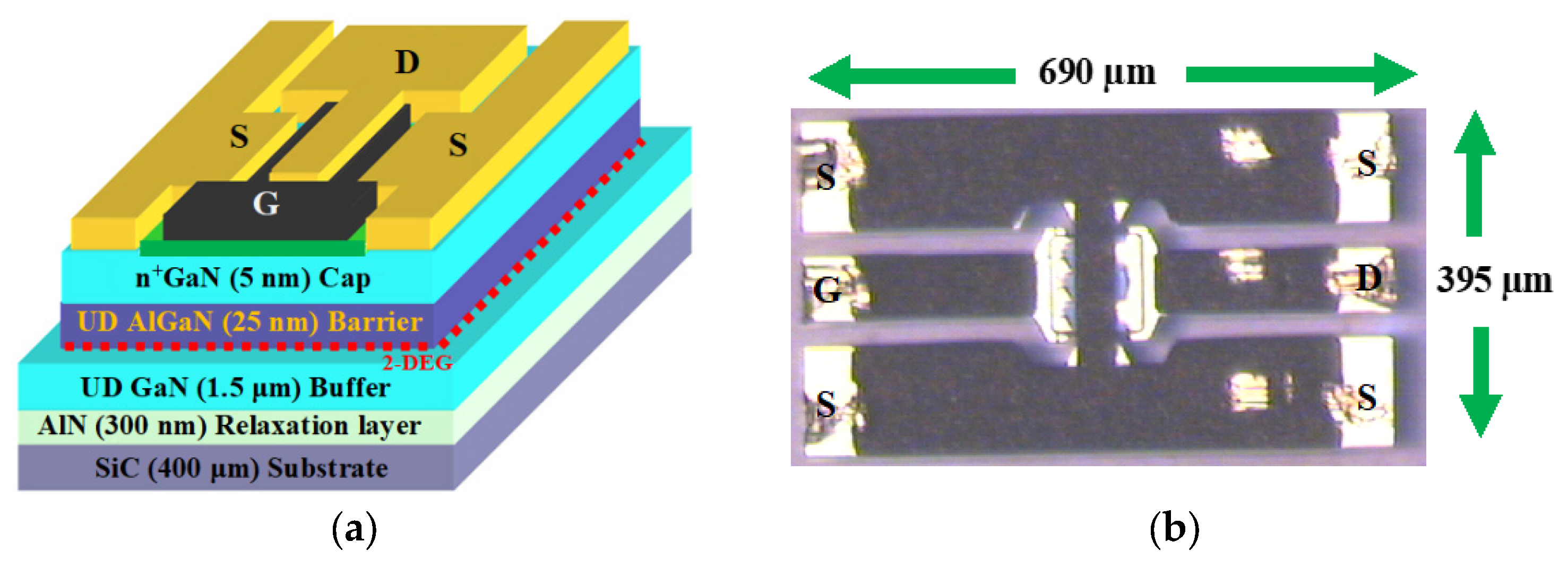
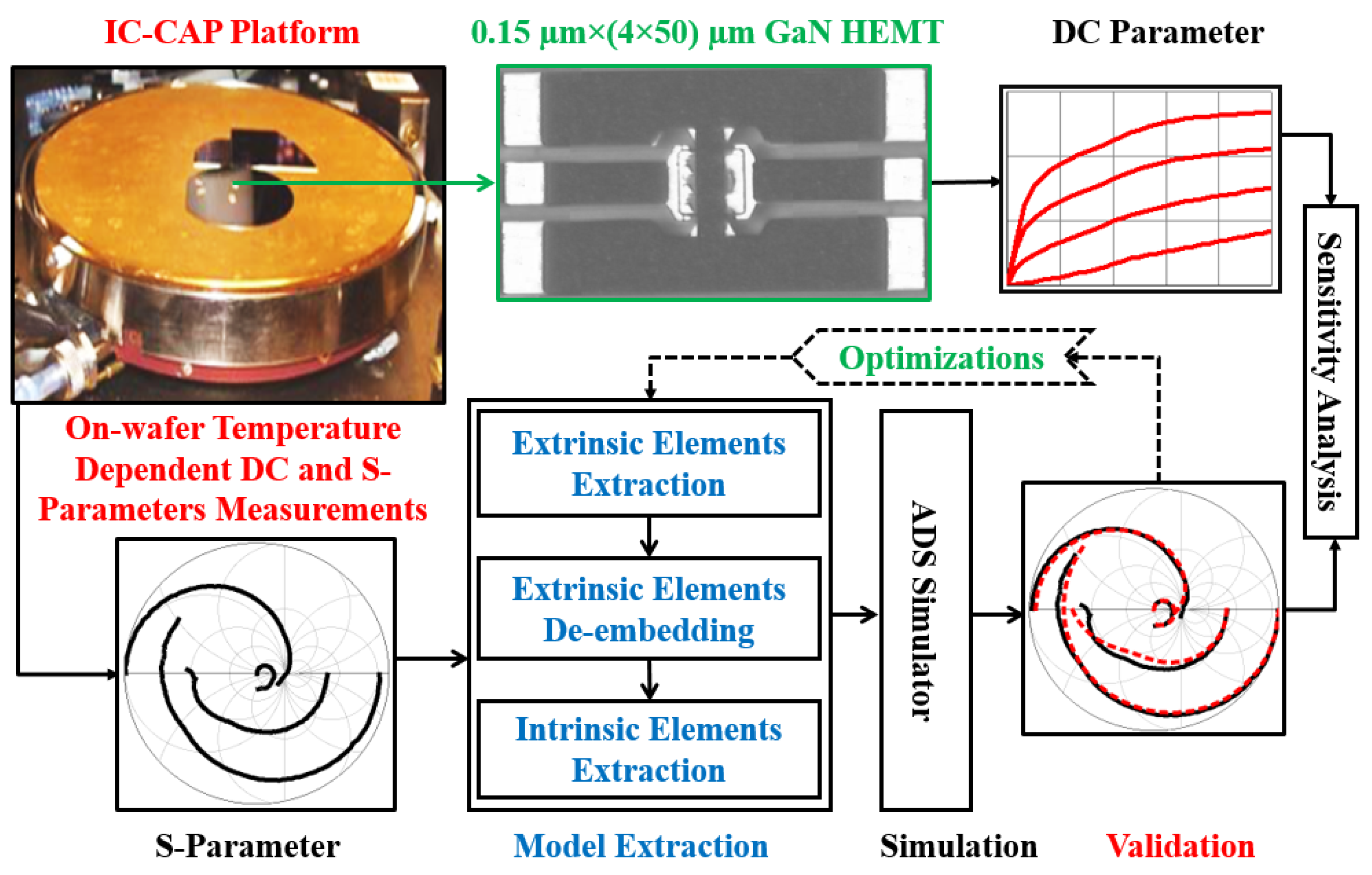


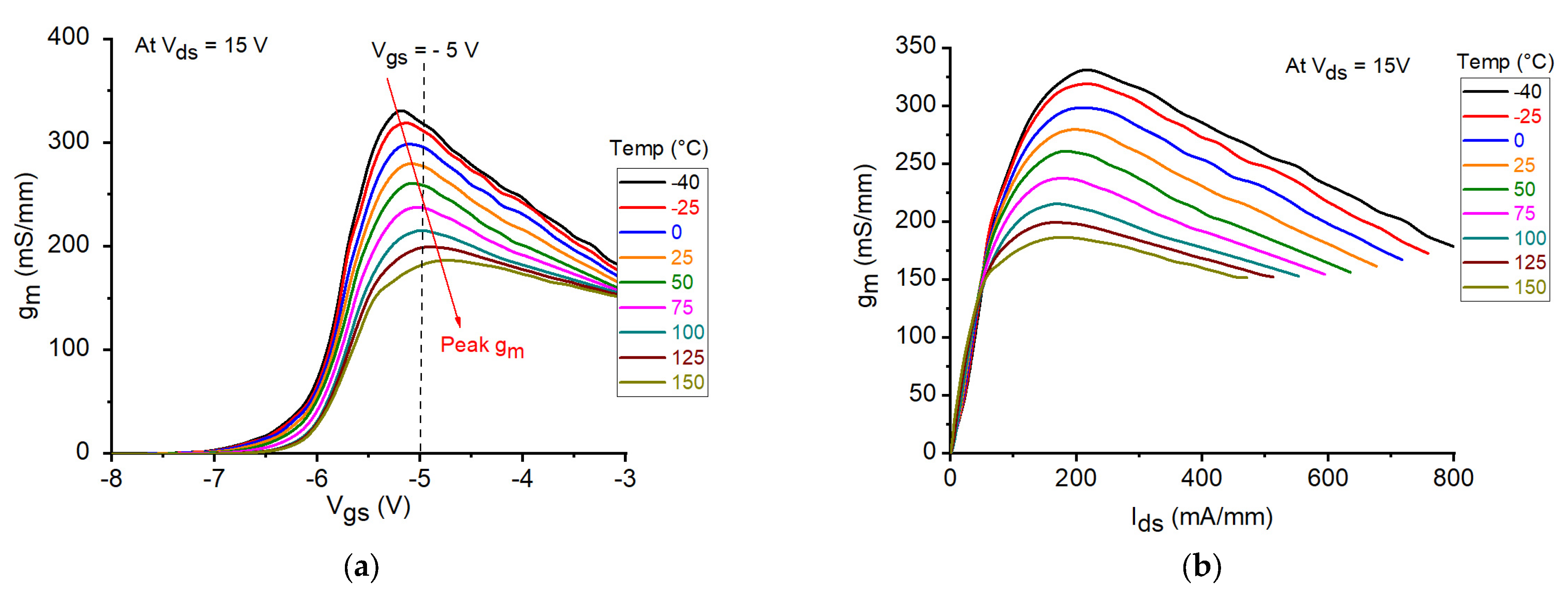
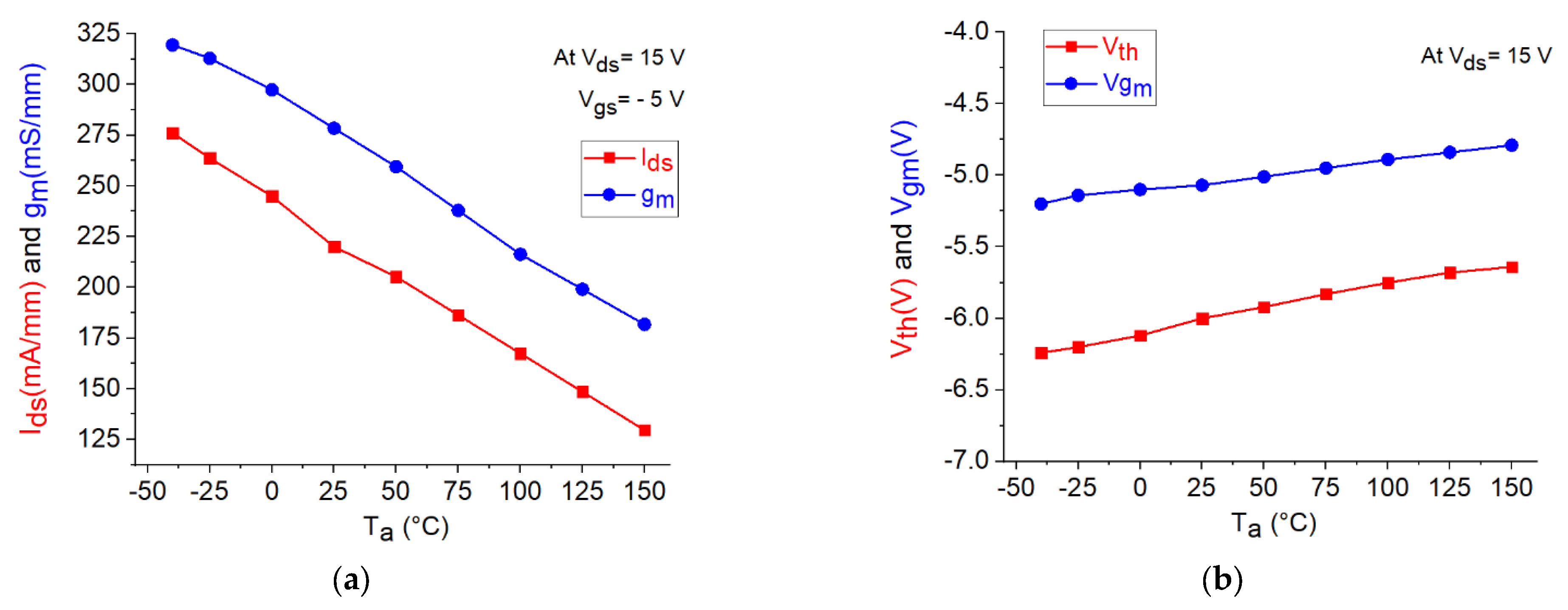

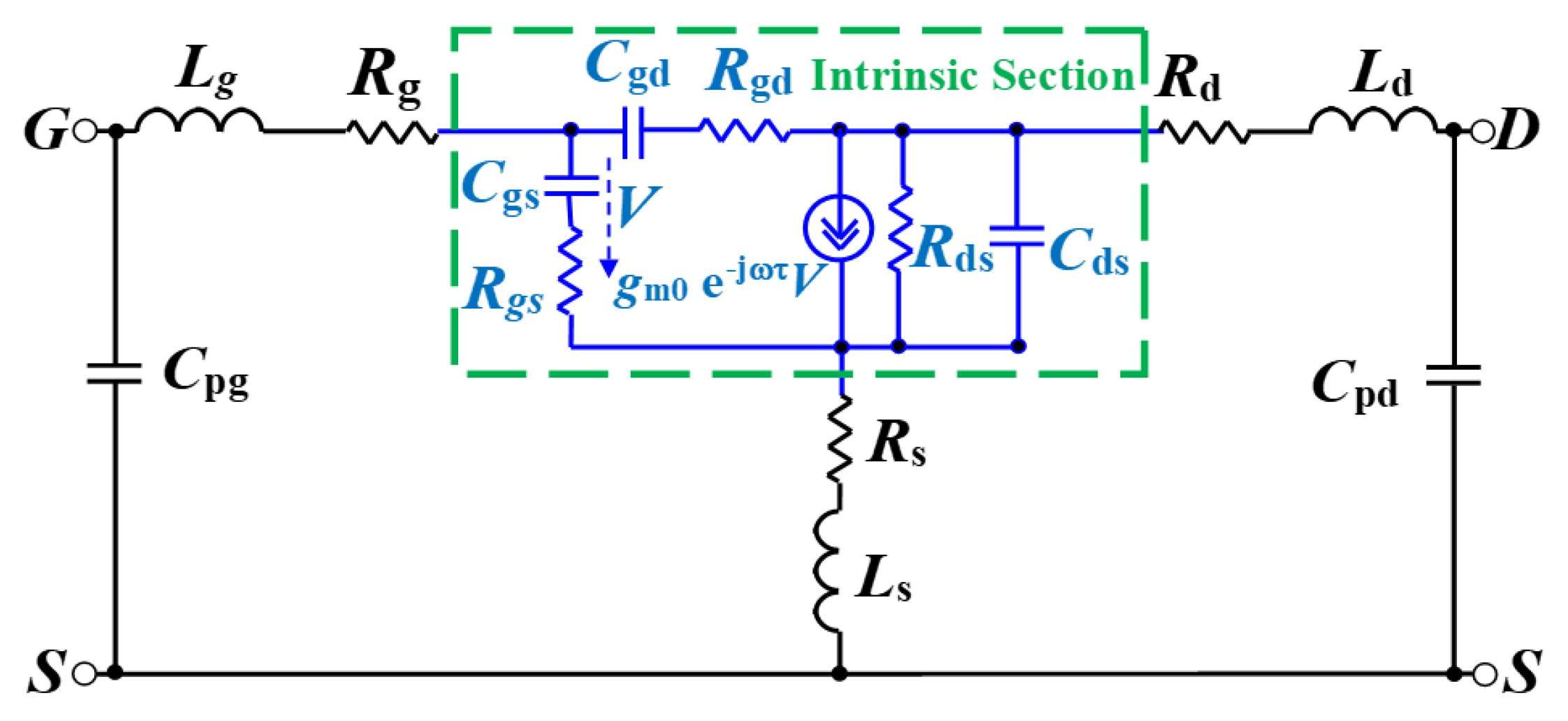
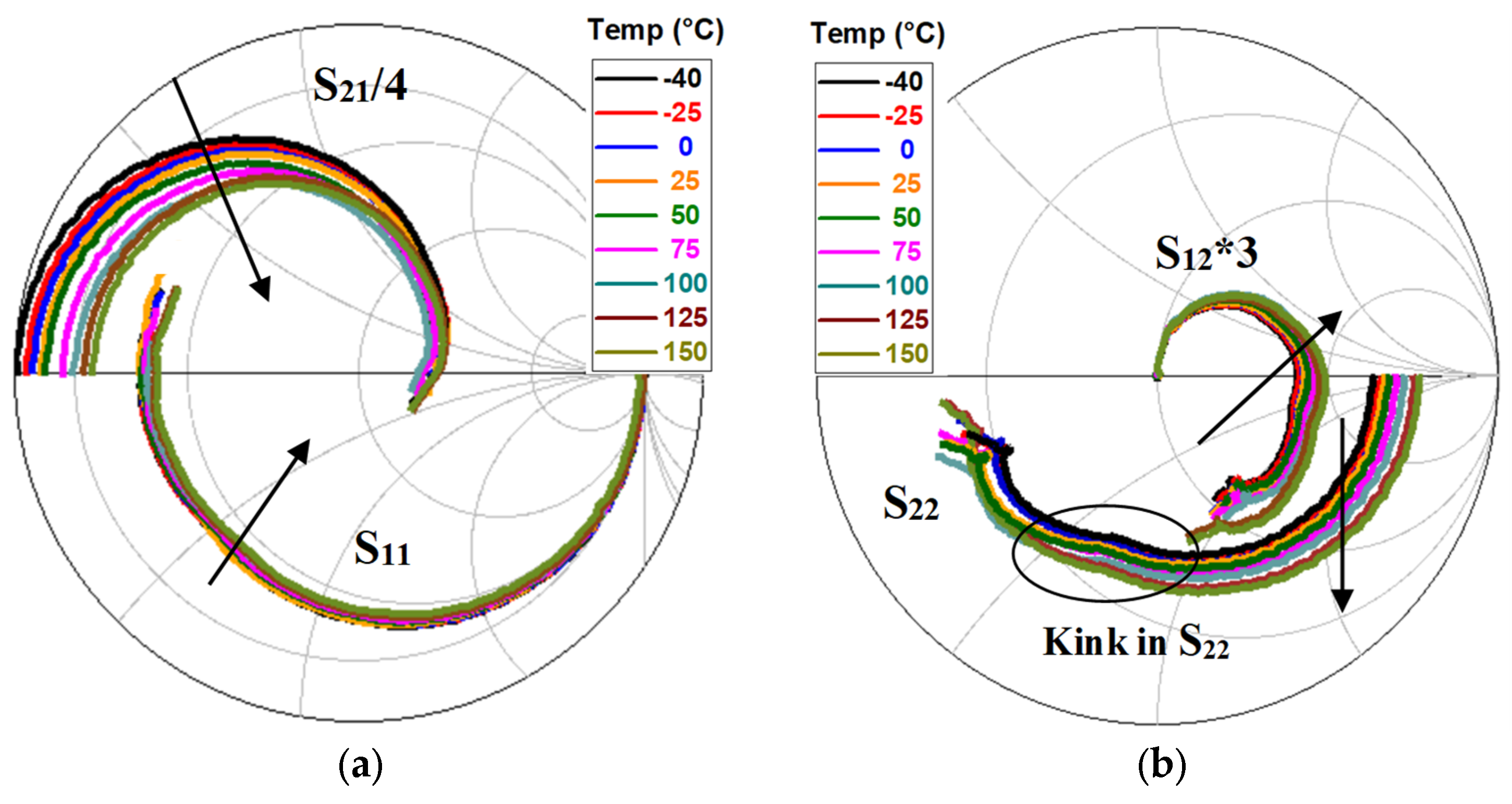
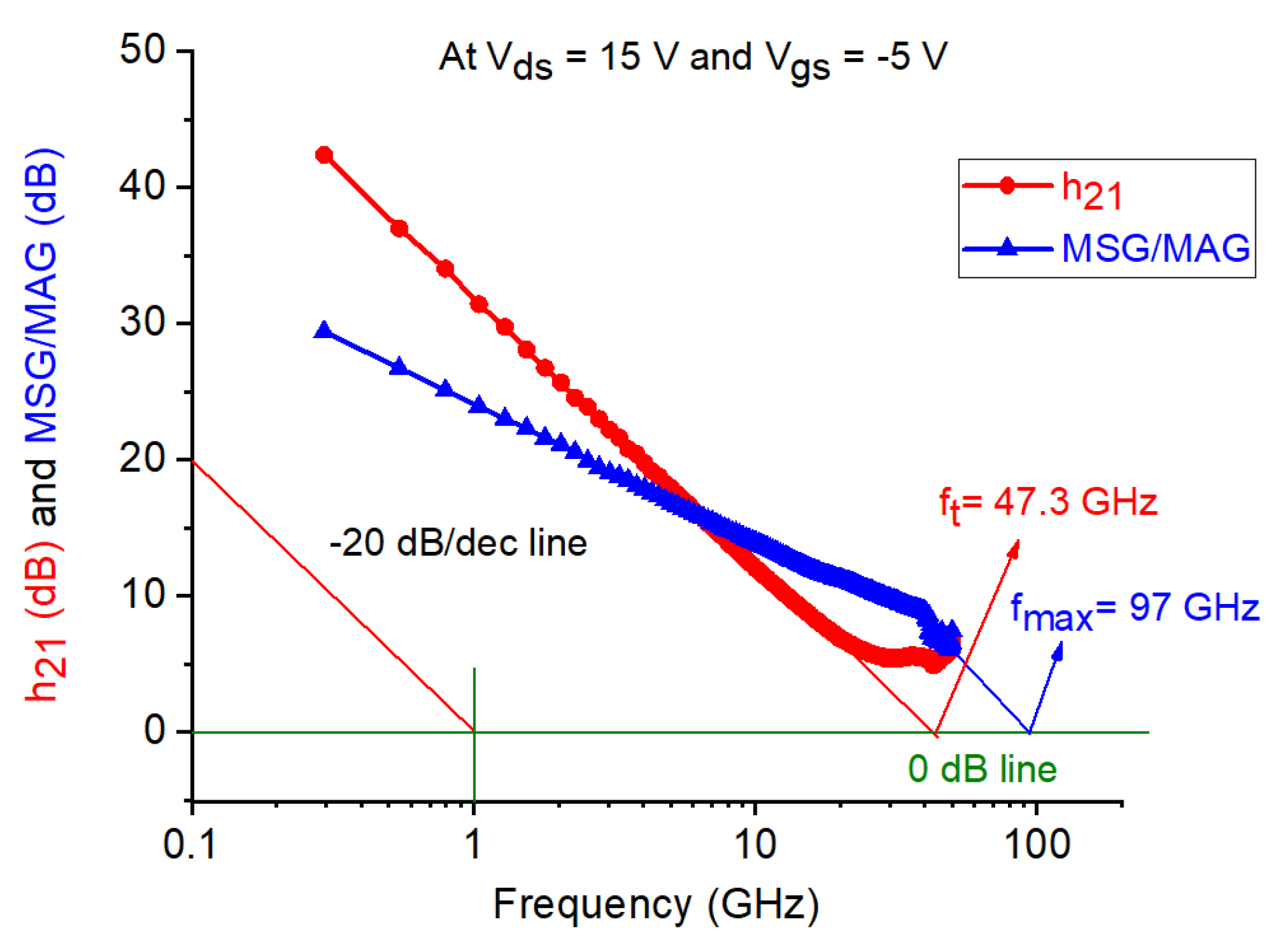

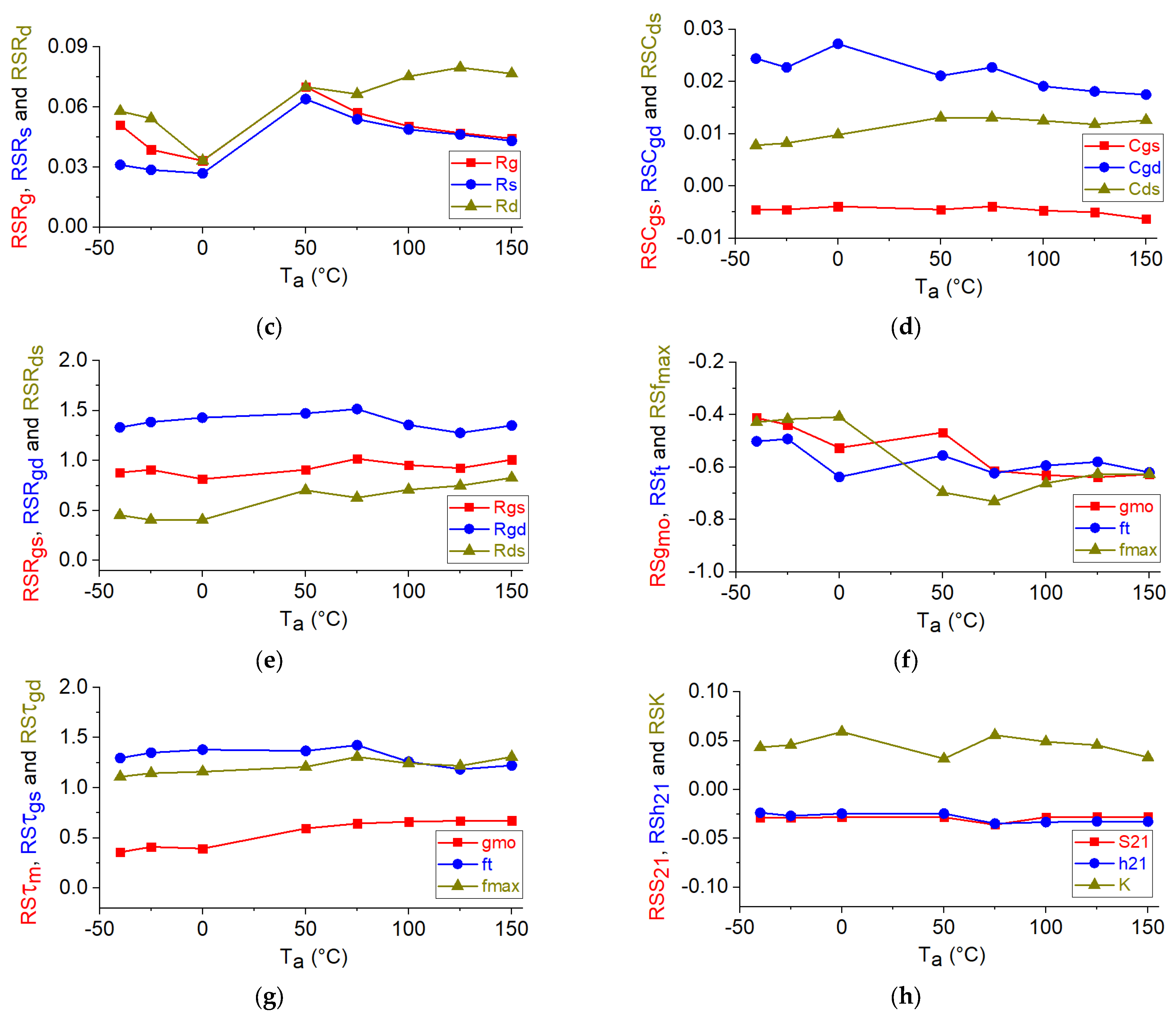
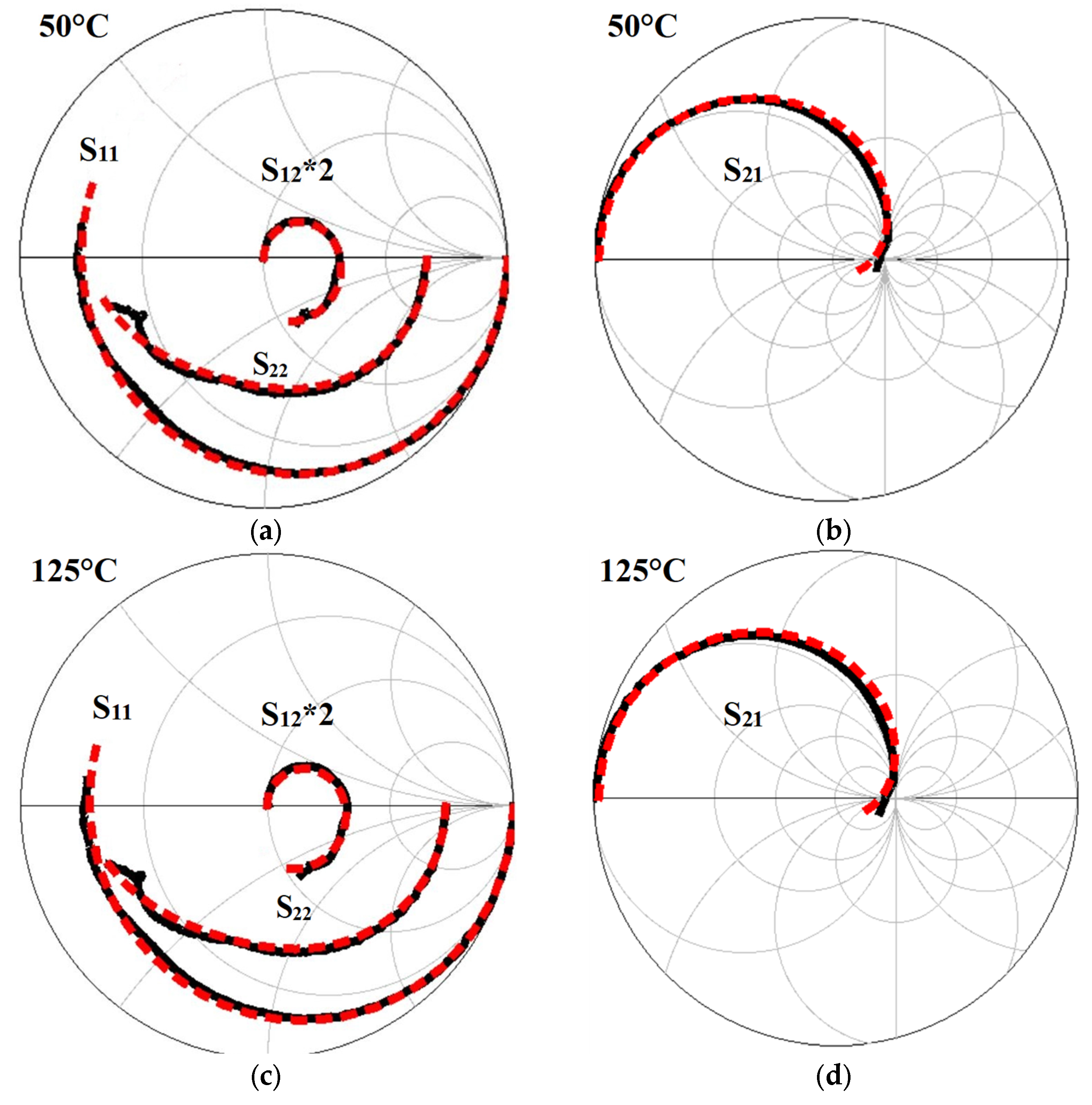
| Parameters | Value | Parameters | Value |
|---|---|---|---|
| Ids (mA) | 44 | Cgs (fF) | 154 |
| gm (mS) | 54 | Cgd (fF) | 28 |
| Vth (V) | −6 | Cds (fF) | 121 |
| Vgm (V) | −5.1 | Rgs (Ω) | 1.7 |
| Cpg (fF) | 50 | Rgd (Ω) | 11.3 |
| Cpd (fF) | 86 | Rds (Ω) | 225 |
| Lg (pH) | 141 | gmo (mS) | 63 |
| Ls (pH) | 1.8 | τm (ps) | 3.0 |
| Ld (pH) | 63 | τgs (ps) | 1.6 |
| Rg (Ω) | 2.7 | τgd (ps) | 2.0 |
| Rs (Ω) | 3.0 | ft (GHz) | 47.3 |
| Rd (Ω) | 5.8 | fmax (GHz) | 97 |
Publisher’s Note: MDPI stays neutral with regard to jurisdictional claims in published maps and institutional affiliations. |
© 2021 by the authors. Licensee MDPI, Basel, Switzerland. This article is an open access article distributed under the terms and conditions of the Creative Commons Attribution (CC BY) license (https://creativecommons.org/licenses/by/4.0/).
Share and Cite
Alim, M.A.; Gaquiere, C.; Crupi, G. An Experimental and Systematic Insight into the Temperature Sensitivity for a 0.15-µm Gate-Length HEMT Based on the GaN Technology. Micromachines 2021, 12, 549. https://doi.org/10.3390/mi12050549
Alim MA, Gaquiere C, Crupi G. An Experimental and Systematic Insight into the Temperature Sensitivity for a 0.15-µm Gate-Length HEMT Based on the GaN Technology. Micromachines. 2021; 12(5):549. https://doi.org/10.3390/mi12050549
Chicago/Turabian StyleAlim, Mohammad Abdul, Christophe Gaquiere, and Giovanni Crupi. 2021. "An Experimental and Systematic Insight into the Temperature Sensitivity for a 0.15-µm Gate-Length HEMT Based on the GaN Technology" Micromachines 12, no. 5: 549. https://doi.org/10.3390/mi12050549
APA StyleAlim, M. A., Gaquiere, C., & Crupi, G. (2021). An Experimental and Systematic Insight into the Temperature Sensitivity for a 0.15-µm Gate-Length HEMT Based on the GaN Technology. Micromachines, 12(5), 549. https://doi.org/10.3390/mi12050549







